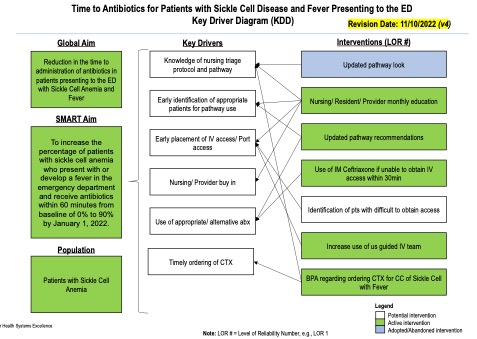Emergency Medicine: Quality Improvement
Emergency Medicine 5 B
346 - Reducing Time to Antibiotics in Patients with Sickle Cell Disease and Fever
Publication Number: 346.209

Shaheen Andreas, DO (she/her/hers)
Pediatric Emergency Medicine Fellow
UCONN/ Connecticut Children's
East Lyme, Connecticut, United States
Presenting Author(s)
Background: Sickle Cell Anemia is a hemoglobinopathy resulting in systemic medical problems including functional asplenia. As a result, patients with sickle cell disease are at higher risk of infections, namely with Streptococcus Pneumoniae and other encapsulated organisms. Patients with Sickle Cell Disease that develop a fever are treated as a medical emergency and typically have to come to the ED for blood work and IV antibiotics. The nationally recognized standard of time to antibiotics in this group of immunocompromised patients is within 60 minutes of arrival to the ED or fever onset.
Objective: Reduction in the time to administration of antibiotics in patients presenting to the ED with Sickle Cell Anemia and fever.
To increase the percentage of patients with sickle cell anemia who present with or develop a fever in the emergency department and receive antibiotics within 60 minutes from baseline of 11% to 90% by January 1, 2023.
Design/Methods:
This quality improvement project conducted in an urban pediatric ED included all patients 0 – 26yo with a diagnosis of sickle cell anemia, who presented to the pediatric emergency department with a fever, or who developed a fever while in the ED. Baseline data was collected from October 2020 through July 2021. Using quality improvement methodology with Plan-Do-Study-Act cycles, interventions began in August 2021. Five PDSA cycles took place with interventions including resident and nursing education, change to institutional pathways, and introduction and adjustments of an electronic best practice advisory (BPA).
Results: 158 encounters were included between October 2020 and October 2022. Baseline data showed an average time from arrival to the ED or start of a fever in the ED to antibiotics of 87 minutes, with 11% of total patients (ED and Admitted patients) receiving antibiotics within the goal of 60 minutes. After 5 PDSA cycles time to antibiotics in this group significantly dropped to 82 minutes, with 28% of total patients receiving antibiotics within 60 minutes. Despite multiple interventions overall time from fever onset or patient arrival to the order of appropriate antibiotics did not change.
Conclusion(s): This quality improvement project was able to significantly reduce the time to initial antibiotics in patients with a diagnosis of Sickle Cell Disease presenting with or developing a fever within the ED. 
.jpg)
.jpg)
